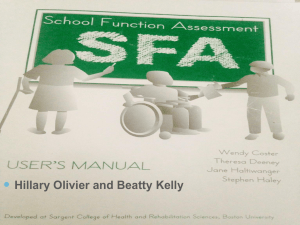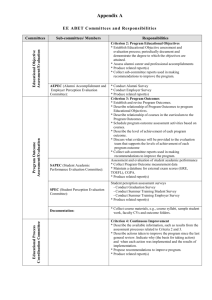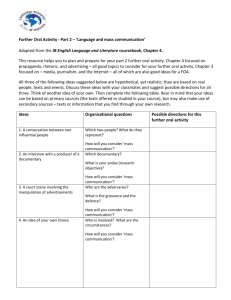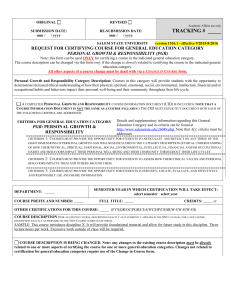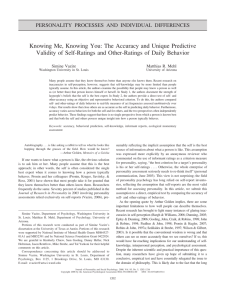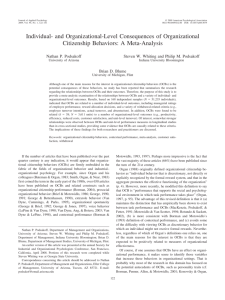File
advertisement
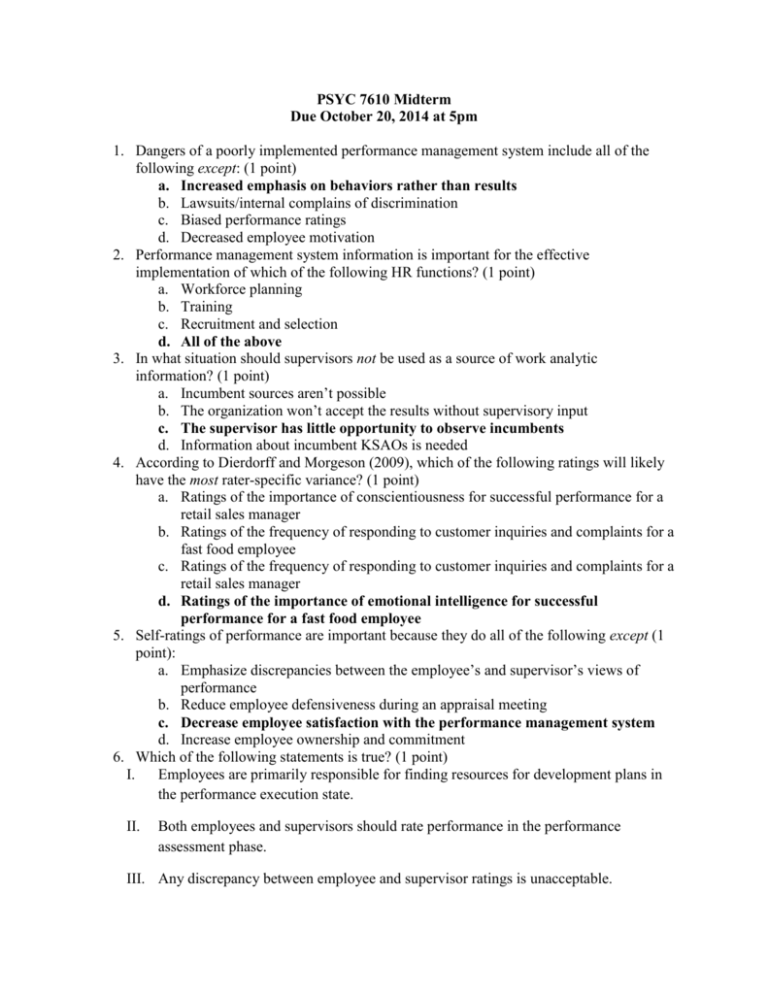
PSYC 7610 Midterm Due October 20, 2014 at 5pm 1. Dangers of a poorly implemented performance management system include all of the following except: (1 point) a. Increased emphasis on behaviors rather than results b. Lawsuits/internal complains of discrimination c. Biased performance ratings d. Decreased employee motivation 2. Performance management system information is important for the effective implementation of which of the following HR functions? (1 point) a. Workforce planning b. Training c. Recruitment and selection d. All of the above 3. In what situation should supervisors not be used as a source of work analytic information? (1 point) a. Incumbent sources aren’t possible b. The organization won’t accept the results without supervisory input c. The supervisor has little opportunity to observe incumbents d. Information about incumbent KSAOs is needed 4. According to Dierdorff and Morgeson (2009), which of the following ratings will likely have the most rater-specific variance? (1 point) a. Ratings of the importance of conscientiousness for successful performance for a retail sales manager b. Ratings of the frequency of responding to customer inquiries and complaints for a fast food employee c. Ratings of the frequency of responding to customer inquiries and complaints for a retail sales manager d. Ratings of the importance of emotional intelligence for successful performance for a fast food employee 5. Self-ratings of performance are important because they do all of the following except (1 point): a. Emphasize discrepancies between the employee’s and supervisor’s views of performance b. Reduce employee defensiveness during an appraisal meeting c. Decrease employee satisfaction with the performance management system d. Increase employee ownership and commitment 6. Which of the following statements is true? (1 point) I. Employees are primarily responsible for finding resources for development plans in the performance execution state. II. Both employees and supervisors should rate performance in the performance assessment phase. III. Any discrepancy between employee and supervisor ratings is unacceptable. IV. Many sources can be utilized for data regarding performance. A. All of the statements are correct. B. I, II, and IV only are correct. C. II and IV only are correct. D. None of the statements are correct. 7. Which of the following are primarily the responsibilities of the supervisor in terms of performance execution? (1 point) a. Regular performance feedback and coaching b. Observation and documentation c. Reinforcement d. All of the above e. B and C only 8. The __________ approach to measuring performance emphasizes cognitive abilities and personality. (1 point) A. trait B. results C. behavior D. objective 9. The behavior approach emphasizes ______________ rather than _____________. (1 point) A. what employees do; employee traits or results B. employee traits; results C. results; employee traits D. None of these are correct 10. Identify and describe three advantages of a good performance management system. (3 points) A good performance management system increases motivation to perform (feedback-lets you know how you’re doing), increases self-esteem (employee feels valued and recognized – a part of the company), and defines the job and performance criterion (employees understand what they should be doing and how performance is classified). 11. Identify and explain two reasons why an accurate work analysis is needed to develop an effective performance management system. (2 points) A work analysis identifies what kinds of performance needs to be measured in addition to identifying behaviors and results associated with performance. A performance management system based on well-conducted work analysis are more likely to be accepted by employees because it’s clearly job-relevant. 12. In the work analysis literature, there is a clear divide between those who argue that there is no objective reality in work analysis, and those who argue that there is an objective reality. Briefly summarize each argument. Then, in 2-3 sentences explain which viewpoint you think is correct, and justify this viewpoint using information about work analysis and/or job performance that we’ve covered in class. (5 points) There are two viewpoints that discuss the accuracy of a work analysis. The first argues that there is no objective standard for work analysis information so therefore the consequential validity of work analysis should be the focus, which is largely proposed by Sanchez and Levine (2000). One of the main points of the first theory is that due to idea behind true score for a work analysis, it does not hold up and thus its difficult to find any objective criterion. The second argues there is an objective standard for work analysis information, which is largely proposed by Harvey and Wilson (2000). This theory does support the need to focus on consequential validity of work analysis and that there has to be objective reality to work analysis due to people engaging in observable verifiable activities in the work place. Based on both of these theories I would agree with Harvey and Wilson (2000) that work analysis does have an objective reality. I would also agree with the authors that there is much work to be done on work analysis for this to be achieved fully, such as making improvements to methodological gaps in work analysis research. By doing so, this could reduce the instances of practitioners misusing work analysis data and therefore making flawed inferences based on the data. I would also agree that just because there is within job disagreement this does not always mean it is due to error, rather that there could be serious differences in the way that employees complete their job. 13. Identify and explain 3 potential sources of inaccuracy in work analysis, based on Morgeson and Campion’s (1997) framework. (3 points) There are two sources of inaccuracy in work analysis: social sources and cognitive sources. Social sources include conformity (going along with the group), extremity shifts (opinions usually become more extreme after discussion than originally), and motivation loss (sources don’t feel like helping – social loafing or WA is not seen as meaningful. Cognitive sources include information overload, use of heuristics (can be inaccurate), and categorization (tendency to categorize information and judgments made based off them). 14. What are generalized work activities (GWAs)? How do they differ from tasks? Using O*NET, list 1 GWA and 1 task for the occupation “Industrial-Organizational Psychologist.” (3 points) GWAs are generalized work activities, which are activities that are common across many industries and occupations, and more specifically are very general categories of work activities. Whereas tasks are specific tasks performed by members of an occupation, there are occupation specific which means they are not designed to apply to a large number of occupations. A task for an I/O Psychologist would include providing expert testimony in employment lawsuits. A GWA for an I/O Psychologist would include judgment and decision-making. 15. Identify and describe the 3 elements of performance planning. (3 points) There are three elements of performance planning: Results, Behaviors, and Development plan. Results are what outcomes the employee is responsible for which includes the main areas in which an employee is expected to perform (i.e. car salesman – sell automobiles to customers). Behaviors are what a person does on the job, such as networking with potential customers. Development plan usually includes both results and behaviors. Both supervisors and employees should agree on the areas that need improvement and what goals should be reached. For example, for a car salesman, a results goal would include selling a certain number of cars to clients, and a behavior goal would include behaviors such a networking to assist in meeting the results. 16. Identify and describe 3 purposes of strategic planning. (3 points) 1. Helps organization define who they are and what their purpose is. More specifically what their focus is, for example environmental safety or providing sustainable products to consumers. 2. Helps organizations plan for the future, and forces them to decide which direction the want to go. Specifically, what the company wants to accomplish in a certain amount of time, for example become a fortune 500 Company by 2017 or reduce gas emissions by 20% by 2017. 3. Requires organizations to analyze their environment, which also alerts them to potential problems and changes ahead. For example, changes in economic market such as labor costs or demand for product/service (i.e. whether or not demand will sustain or if demand is limited – trendy). 17. For an organization that you have worked for, briefly evaluate 3 components of its external environment, and 3 components of its internal environment. Based on this analysis, does this organization have leverage, a constraint, a vulnerability, or a problem? Explain your decision. (8 points) lecture 6 Mental health profession External -Social aspect – increased acceptability of mental illness and treatment of such. -Technological – increase of telemedicine use could increase the number of facilities worked at and patients seen. -Customers – increase of social acceptability, increase of people seeking treatment Internal -Politics – no rivalries/divisions -Size – growing rapidly – causing operations to not run as efficiently -Processes – could be more efficient Based off the strength in the opportunity aspect but lacking in the organizational feature makes this situation a constraint. Need for more employees, but organizational features view processes are more efficient that they really are. 18. According to Campbell et al. (1993), what are the 3 determinants of job performance? If one of these determinants is missing, what happens to job performance? (2 points) There are three antecedents of performance: declarative knowledge, procedural knowledge, and motivation. Performance equals declarative knowledge times procedural knowledge times motivation. Based on this equation if any component is lacking (therefore = 0) the other components will also equal zero and performance will suffer. 19. What is criterion deficiency? What is criterion contamination? Give one example of each. Examples pulled from the slides or the text will not receive any credit. (4 points) Criterion deficiency is when a measure is missing something important, or when the ultimate criterion and actual criterion do not match. An example of criterion deficiency would be a measure of conscientiousness, but failing to include self-efficacy as one of the variables. Criterion contamination is when something is included in the measurement that is irrelevant. An example of criterion contamination would be a measure of conscientiousness but including eye color as one of the predictors. 20. What is organizational citizenship behavior? How does it differ from task performance? Using Borman et al.’s (2001) classification of OCBs, list and classify 3 OCBs. Examples pulled from the slides or the text will not receive any credit. (5 points) OCB is behavior that goes beyond what is expected and also known as non-task performance. There are 3 types of OCB: personal support, organizational support, and conscientious initiative. Personal support includes helping others in the organization, such as assisting a co-worker purchase and/or set up supplies for an important meeting. Organizational support includes supporting and standing behind the organization (i.e. loyalty) such as if the organization is forced to make cut backs supporting the organization for doing so. Conscientious initiative includes putting in extra effort as needed, such as contributing in any way you can to help ensure an organizational goal is accomplished such as using personal time or resources to do so (i.e. hosting a dinner party to help gain an important client). Task performance is classified by activities that help transform materials into goods and services that are produced by the organization.

